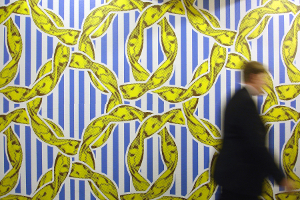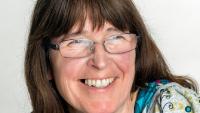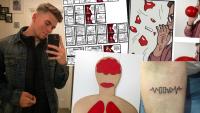Is being creative related to my stammer?

(This article was originally published in 2014)
Artist, writer and blogger Jonathan Velardi wonders how far stammering has influenced his career choice, and those of other creative professionals.
As most lunches between young professionals go, the inevitable subject of work is introduced into the conversation. This generally turns an otherwise relaxing gathering into a pseudo-counselling session, resulting in the prescription of wine or other spirited relief. As a good listener, by default I adopt the role of soundboard as friends gush about their career quandaries. During one such lunch, and barely halfway through my course, I was posed the hypothetical question: "What would you do if you weren't creative?" All of a sudden I'd lost my appetite.
Pen and paper have been my inanimate comrades for as long as I can remember, as has my stammer. I loved to draw from an early age and I was happily amused producing of surreal worlds. I was artistic throughout adolescence and fortunately learned to accept my stammer with thanks to a supportive upbringing.
Pen and paper have been my inanimate comrades for as long as I can remember, as has my stammer.
Having inherently signed up to the old adage 'a picture is worth a thousand words' even before I knew how to write, it wasn't until I had to decide what to study at university that being creative become a legitimate avenue to pursue. At no stage had this adage been more pertinent then when I began exploring my own visual practice at art school.

I embarked on a Bachelor's degree at The Slade School of Fine Art where I was introduced to alternative means of expression through a conceptual framework. I honed my ability to create a visual language liberated from having to use direct speech. Even when these messages edged towards the abstract, there was always a well-worded press release close by that I could rely on to explain it for me. I maintain my art practice to this day and have turned to writing about the arts to compliment my interest in visual dialogue from the perspectives of both artist and viewer. Writing also provides me with an eloquent outlet to compose my thoughts and opinions with the precise words I wish to use, rather than a mental queue of substitutes that usually formulate when in conversation.
Creativity & stammering
In search for an answer to what I would do were I not creative, I wondered whether the essence of being creative was somehow related in any way to my stammer. Is my verbal ability subconsciously linked to my career choices via my artistic talent? I therefore wanted to explore whether other people who stammer and who followed a career in a creative industry — such as artists, advertisers, graphic designers and illustrators — were products of their speech; had they recognised the dominance of visual communication over speech in their daily lives, if at all?Jo

I approached the British Stammering Association (BSA, now STAMMA) in the hope that they could put me in contact with creative people who stammer from around the country to interview. Interested participants were invited to answer 16 questions via email. The questionnaire spanned their verbal ability and creative activity from childhood through to their present occupation. Discovering why they were attracted to their profession and whether they studied in a similar visually dominant creative field were areas of inquiry that reflected my own curiosity around the career choice I had made.
My research drew interesting results amongst the participating male and female young professionals — all of whom were under 30 and stammered. Unsurprisingly, the majority were ardent drawers as children and for many their creative streak was cultivated through to higher education. They were aware of the influence visual interpretation had within their job roles respectively and no participant felt hindered by their speech in the workplace.
When asked whether communicating in visual terms was easier than speaking, some admitted the benefits of a visual language that allowed them to be clear and coherent, instead of experiencing the predictable cycle of verbal obstacles involved in dysfluent speech. Others deemed imagery as no substitute for verbal dialogue. I personally wouldn't mind having images of vowels or semi-vowels to wave in the air during conversation (my Achilles heel and something I don't often utter off the page for obvious reasons).
It was evident that a creative industry valued the skill of generating visual communication to be just as important as that of verbal interaction. The consensus that being strong creatively may have contributed to a desire to engage in alternative means of communication beyond speech appeared in hindsight. An unconscious survival mechanism perhaps, which would place people who stammer in good stead were verbal communication to become extinct. An outrageous theory I admit, but one with some foundation in our ever-increasing digital-bound age.
Social media: a help or hindrance?
A vein of significance that ran through my investigation was the very dependence on social media. Digital communication is already a strong force within creative fields — all of the participants in my investigation were personal social media users and many used it as part of their job role. This is visual communication with social consequences. Virtual interfaces are not only limiting our expression in 140 characters but are further diminishing the need for speech and subsequent intercommunication.

What does this mean for people who stammer? Participant Stacey, a graphic designer, admits social media has benefitted her day-to-day ability to communicate, "If I'm in a quiet mood because I know I'm stammering more that day, having Facebook and Twitter gives me the chance to fully open up to new friends and co-workers who I may feel reluctant to show my stammer to for the first time." The BSA agrees that social media has opened up a whole new world for the stammering community across generations: "Social media can be a lifeline. People who stammer can share their thoughts, emotions and experiences in a way that wasn’t possible before."
The participants concluded that it is impossible to avoid talking in the workplace — so is social media a short-term blessing or long-term hindrance for people who stammer? With dedicated pages on Facebook and Twitter, the BSA encourages its members to post videos of themselves talking and to use platforms such as Skype and Google Hangouts to connect with others who stammer. Not only does this increase self-confidence, it also inspires the practice of actively implementing a technique in the hope for long-term improvement. In as much as online presence around stammering has the ability to provide a supportive arena, its awareness is subsequently made more public in a way never before achieved in the pre-internet era. The witty memes posted on BSA's Twitter account are an example of how stammering has embraced social media through the visual that promotes a sense of inclusivity rather than peripheral spectator.
It is inconceivable to imagine any industry abandon social media as a means to communicate. Amongst the young professionals who took part in my investigation, they felt it provides a level playing field as creative industries rely on virtual platforms to communicate with wider audiences. For the next generation of young professionals who stammer, it is essential for speech therapy to adjust to the evolution of workplace dynamics.
Pronouncing pixels
What I would be, were I not creative is a question that I can now more easily digest. Considering my own choices to date, I conclude that knowing I had the ability to communicate visually on days when my fluency barometer was low, had intrinsically given me an element of reassurance, which has undoubtedly contributed to my career decisions.
What attracts and excites me the most about the current digital climate is both the efficacy and permanency of visual communication that skirts unwanted blocks, repetition or vowel avoidance — simply a fluent, affirmative statement communicated in pixels. My Achilles heel may be on the mend, as is my appetite.
Jonathan is a freelance writer and blogger on arts, culture and lifestyle. Visit jonathanvelardi.blogspot.com to see and read about some more of his work.
Would you like to write an article or tell us about anything you've created? See Submit Something For The Site or email editor@stamma.org for details.
This article was first published as 'Look who's talking' in our old magazine 'Speaking Out', Summer/Autumn 2014.

































